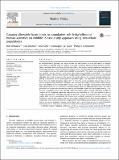Files in this item
Gauging allowable harm limits to cumulative, sub-lethal effects of human activities on wildlife : a case-study approach using two whale populations
Item metadata
| dc.contributor.author | Williams, Rob | |
| dc.contributor.author | Thomas, Len | |
| dc.contributor.author | Ashe, Erin | |
| dc.contributor.author | Clark, Christopher W. | |
| dc.contributor.author | Hammond, Philip S. | |
| dc.date.accessioned | 2016-05-03T11:30:11Z | |
| dc.date.available | 2016-05-03T11:30:11Z | |
| dc.date.issued | 2016-08 | |
| dc.identifier | 242338792 | |
| dc.identifier | ecc911c7-726b-4cb0-96df-512442560c27 | |
| dc.identifier | 84964489796 | |
| dc.identifier | 000379371500007 | |
| dc.identifier.citation | Williams , R , Thomas , L , Ashe , E , Clark , C W & Hammond , P S 2016 , ' Gauging allowable harm limits to cumulative, sub-lethal effects of human activities on wildlife : a case-study approach using two whale populations ' , Marine Policy , vol. 70 , pp. 58-64 . https://doi.org/10.1016/j.marpol.2016.04.023 | en |
| dc.identifier.issn | 0308-597X | |
| dc.identifier.other | RIS: urn:343C3BCE746BA63114118A7348FFF099 | |
| dc.identifier.other | ORCID: /0000-0002-2381-8302/work/47531598 | |
| dc.identifier.other | ORCID: /0000-0002-7436-067X/work/29591652 | |
| dc.identifier.uri | https://hdl.handle.net/10023/8716 | |
| dc.description | Rob Williams was supported by a Marie Curie International Incoming Fellowship within the 7th European Community Framework Programme (Project CONCEAL, FP7, PIIF-GA-2009-253407). | en |
| dc.description.abstract | As sublethal human pressures on marine wildlife and their habitats increase and interact in complex ways, there is a pressing need for methods to quantify cumulative impacts of these stressors on populations, and policy decisions about allowable harm limits. Few studies quantify population consequences of individual stressors, and fewer quantify synergistic effects. Incorporating all sources of uncertainty can cause predictions to span the range from negligible to catastrophic. Two places were identified to bound this problem through energetic mechanisms that reduce prey available to individuals. First, the US Marine Mammal Protection Act's Potential Biological Removal (PBR) equation was used as a placeholder allowable harm limit to represent the number of animals that can be removed annually without depleting a population below agreed-upon management targets. That rephrased the research question from, “How big could cumulative impacts be?” to “How big would cumulative impacts have to be to exceed an agreed-upon threshold?” Secondly, two data-rich case studies, namely Gulf of Maine humpback and northeast Pacific resident killer whales, were used as examples to parameterize the weakest link, namely between prey availability and demography. Given no additional information, the model predicted that human activities need only reduce prey available to the killer whale population by ~10% to cause a population-level take, through reduced fecundity and/or survival, equivalent to PBR. By contrast, in the humpback population, reduction in prey availability of ~50% was needed to cause a similar, PBR-sized effect. The paper describes an approach – results are merely illustrative. The two case studies differ in prey specialization, life history, and, no doubt, proximity to carrying capacity. This method of inverting the problem refocuses discussions around what the level of prey depletion – via competition with commercial fisheries, displacement from feeding areas through noise-generating activities, or acoustic masking of signals used to detect prey – would have to occur to exceed allowable harm limits set for lethal takes in fisheries or other, more easily quantifiable, human activities. | |
| dc.format.extent | 7 | |
| dc.format.extent | 516565 | |
| dc.language.iso | eng | |
| dc.relation.ispartof | Marine Policy | en |
| dc.subject | Allowable harm limits | en |
| dc.subject | Cumulative impact | en |
| dc.subject | Industrialization | en |
| dc.subject | Marine mammal | en |
| dc.subject | Ocean | en |
| dc.subject | Population dynamics | en |
| dc.subject | Whale | en |
| dc.subject | QH301 Biology | en |
| dc.subject | NDAS | en |
| dc.subject | SDG 14 - Life Below Water | en |
| dc.subject.lcc | QH301 | en |
| dc.title | Gauging allowable harm limits to cumulative, sub-lethal effects of human activities on wildlife : a case-study approach using two whale populations | en |
| dc.type | Journal article | en |
| dc.contributor.sponsor | European Commission | en |
| dc.contributor.institution | University of St Andrews. Statistics | en |
| dc.contributor.institution | University of St Andrews. School of Mathematics and Statistics | en |
| dc.contributor.institution | University of St Andrews. Marine Alliance for Science & Technology Scotland | en |
| dc.contributor.institution | University of St Andrews. Centre for Research into Ecological & Environmental Modelling | en |
| dc.contributor.institution | University of St Andrews. School of Biology | en |
| dc.contributor.institution | University of St Andrews. Sea Mammal Research Unit | en |
| dc.contributor.institution | University of St Andrews. Scottish Oceans Institute | en |
| dc.identifier.doi | 10.1016/j.marpol.2016.04.023 | |
| dc.description.status | Peer reviewed | en |
| dc.identifier.grantnumber | 253407 | en |
This item appears in the following Collection(s)
Items in the St Andrews Research Repository are protected by copyright, with all rights reserved, unless otherwise indicated.

